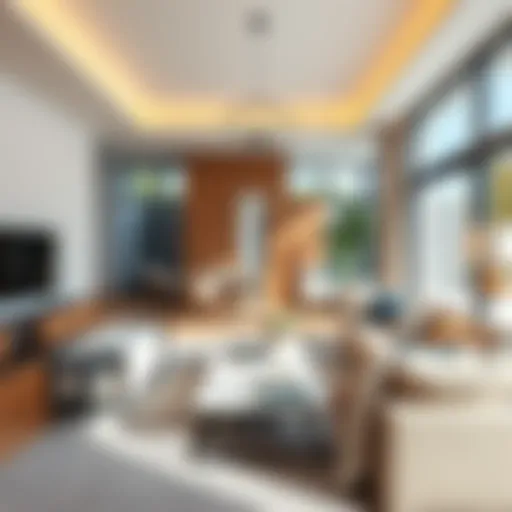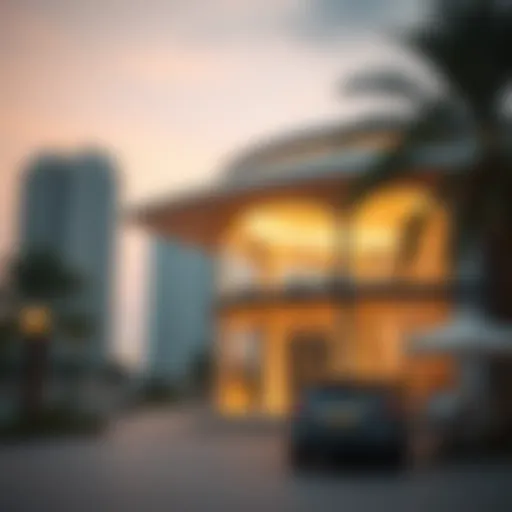Exploring NEOM: The Future of Urban Living in the UAE


Intro
As the world gears up for urbanization at an unprecedented scale, NEOM emerges as an extraordinary undertaking that aims to set a new benchmark in future urban living. Nestled in the northwestern region of Saudi Arabia, this massive project promises to intertwine cutting-edge technology with sustainable living, resulting in a city unlike any other. By understanding the intricate layers of NEOM, one can appreciate the vast potential it holds not only for the UAE but also for the broader region.
The vision is clear: NEOM aims to serve as a hub of innovation, sustainability, and livability. Investors, homeowners, real estate agents, and analysts must grasp the market conditions and investment opportunities surrounding this ambitious initiative, as it reveals not only a new urban landscape but an evolving economic paradigm.
Market Trends
Current Real Estate Landscape
At present, the real estate environment in the UAE is buzzing with activity, largely spurred by initiatives like NEOM. This ambitious project has rekindled interest in the region's property market, prompting both local and international investors to reassess their positions. The landscape is characterized by a mix of modern high-rises and eco-conscious developments aimed at attracting a diverse demographic.
Developers are increasingly embracing innovative approaches whether through smart home features or green energy installations. For example, projects like The Line—a linear city that prioritizes walkability—show how effortlessly modern aesthetics can blend with sustainability. As such, NEOM’s focus on projecting a futuristic lifestyle while maintaining ecological balance is enticing many potential buyers who are looking for properties that align with these values.
Property Price Trends
Observing the waves of growth across various districts, it becomes clear that price trends are fluctuating in tandem with the excitement surrounding NEOM. A well-placed property near the project is viewed as a prime asset, driving prices up significantly. As of the latest reports, regions adjacent to NEOM have seen property values increase by about 15% in just a year, again, demonstrating the ripple effect of NEOM’s presence.
The dynamics of supply and demand further underscore the rising prices. Limited availability of prime land coupled with surging interest underlines a very competitive market. Investors need to act swiftly, as the increasing demand for properties with high-tech amenities isn’t likely to slow down anytime soon.
Intro to NEOM
NEOM stands as a pioneering effort in redefining urban landscapes, attempting to meld the complexities of modern living with sustainable practices. This article intends to highlight NEOM not merely as an ambitious project, but as a beacon of future urban living in the UAE. By embracing cutting-edge technology alongside environmental consciousness, NEOM presents a blueprint for cities that could minimize ecological footprints while maximizing livability.
Focusing on the strategic relevance of NEOM, it’s clear this endeavor is not just about creating a new city but rethinking how urban centers function. This is where the potential benefits come into play, as NEOM aims to attract a diverse demographic, from forward-thinking investors to those seeking innovative living spaces. The planned integration of smart technology into everyday routines could make life smoother and more efficient for residents.
Conceptual Framework
This framework serves as the backbone of NEOM's vision. Instead of designing a city based solely on traditional parameters, NEOM is rooted in rethinking societal structures. The conceptual framework includes principles like sustainability, innovation, and community engagement, ensuring that NEOM adapts to future needs rather than merely catering to present demands. This innovative approach positions NEOM as a significant case study in urban planning discussions.
Strategic Importance
The strategic importance of NEOM cannot be overstated. Located in the northwest of Saudi Arabia, close to the Red Sea, it serves as a natural crossroads between continents. The accessibility provided by this location will play a key role in fostering international relationships and tourism. Furthermore, the project aligns with the Saudi Vision 2030 initiative, showcasing the country’s commitment to diversifying its economy and reducing its dependence on oil. This kind of strategic positioning ensures NEOM is not only a local development but a global focal point.
Historical Context
Understanding the history surrounding NEOM offers valuable insights into its motivations and aspirations. With the rapid economic changes in the Gulf region over the past few decades, there has been an urgent need to innovate and progress away from oil dependence. NEOM emerges from this cultural shift, representing a new chapter that blends tradition with modernity. By examining the historical context, from the region's rich heritage to recent economic challenges, one can grasp why NEOM is seen as a response to both local and global dynamics, and an attempt to carve a niche for itself in a world that is constantly evolving.
"NEOM could redefine what it means to live in a city, offering new models for urban living that are both possible and necessary."
In summation, the exploration of NEOM is not simply an examination of physical infrastructure but rather an investigation into the future of urban environments. By dissecting its conceptual foundations, strategic merit, and historical precursors, we can cultivate a more profound understanding of this remarkable initiative as it sets out to shape the urban landscapes of tomorrow.
Core Principles of NEOM
The ambitious project of NEOM is rooted in core principles that embody a forward-thinking approach to urban living. These principles, encompassing sustainability, technological integration, and community-centric designs, form the bedrock of a future-ready city that aims to enhance both the quality of life and the environment. In this article, we will explore each of these core principles, elucidating their significance and implications on urban living in the UAE.
Sustainability Initiatives
Renewable Energy Goals
One of the cornerstones of NEOM's sustainability initiatives is its renewable energy goals. This aims to transform the energy landscape by relying heavily on sources such as solar, wind, and hydrogen. The key characteristic of NEOM's renewable energy strategy is its ambition to operate entirely on renewable energy by 2030, which not only reduces reliance on fossil fuels but also aligns with global efforts to combat climate change.
Collaboration with leading experts in the field of renewable resources distinguishes NEOM. With an emphasis on efficiency and innovation, this approach fosters an environment that prioritizes ecological balance. One unique feature is the utilization of floating solar panels in water bodies, maximizing energy production without requiring new land.
However, the transition to 100% renewable energy is not without its challenges. Initial setup costs can be high, and there may be periods of intermittency in power supply. Nevertheless, this is a small price to pay for the long-term ecological and economic benefits these initiatives promise.
Water Conservation Strategies
In a region where water resources are scarce, NEOM's water conservation strategies are crucial for sustaining both the environment and its inhabitants. The key characteristic here involves advanced technologies that purify water and reduce wastage, such as smart irrigation systems and greywater recycling.
These techniques highlight NEOM's commitment to efficient water use, showcasing how technology can play a pivotal role in ensuring water security. A unique feature worth noting is the integration of desert flora which helps retain moisture in the soil and reduces overall water consumption in landscaping.
While these water conservation efforts present significant advantages, like decreased reliance on desalination plants, they are also complex and require continuous public education and infrastructure investment to maintain their effectiveness.
Waste Management Systems


The waste management systems in NEOM are designed to adhere to a circular economy model. This approach focuses on minimizing waste generation and maximizing the reuse and recycling of materials. A key characteristic of this system is its emphasis on zero waste to landfill by leveraging advanced technologies such as bio-digesters and automated sorting facilities.
This model enhances the efficiency of resource utilization, supporting the economic and ecological goals of NEOM. An interesting feature is the community engagement programs that teach residents about waste segregation and responsible consumption, fostering a culture of sustainability.
The potential downside of implementing such a comprehensive waste management system lies in the need for consistent user participation and the complexity of the waste stream. If public cooperation falters, achieving zero waste can be ambitious at best.
Technological Integration
Smart City Features
NEOM is setting the stage for smart city features that prioritize efficiency and livability. The essence of these features lies in the use of Internet of Things (IoT) technology to create an integrated urban ecosystem. From smart traffic management systems to energy-efficient buildings equipped with sensors, these elements collectively enhance the quality of city life.
A unique aspect of NEOM's smart features is the real-time data collection that helps in monitoring energy consumption patterns, allowing for predictive maintenance and resource optimization. This systematic integration offers residents a seamless experience from their smart homes to smart public transport.
However, one significant challenge is ensuring cybersecurity for these increasingly interconnected systems. A breach could undermine the very efficiency that NEOM aims to achieve, necessitating robust protective measures from the onset.
Artificial Intelligence Applications
Artificial intelligence (AI) plays a pivotal role in NEOM, enabling intelligent decision-making across various sectors. The applications are diverse ranging from traffic management to healthcare services. One key characteristic of AI applications is their ability to analyze massive data sets, providing insights that guide urban planning and resource allocation.
A unique feature is the use of predictive analytics to foresee and manage urban challenges before they escalate, effectively making NEOM a proactive, rather than reactive, urban environment.
While the applications of AI promise numerous benefits, such as greater efficiency and improved services, there are concerns regarding data privacy and ethical considerations surrounding algorithm biases. Ensuring transparency in AI technologies and protecting personal data will be vital as NEOM advances.
Blockchain in Governance
The incorporation of blockchain in governance is another innovation within NEOM. By leveraging blockchain technology, NEOM aims to enhance transparency and trust between the government and its citizens. Key characteristics include secure digital identities and transparent record-keeping of transactions and services.
This unique feature not only streamlines bureaucratic processes by reducing paperwork, but also empowers residents through the control of their own data. Furthermore, blockchain can facilitate a participatory governance model, enhancing civic engagement.
Nonetheless, the complexity of blockchain technology presents a barrier to wide-scale adoption, and ensuring widespread understanding among citizens is essential for its successful implementation.
In summary, NEOM's core principles encapsulate a forward-looking vision that invites investment, drives technological advancements, and underscores a commitment to sustainability. As we delve deeper into the economic impacts, sociocultural aspects, and potential challenges, one can see how these principles intertwine to create a blueprint for future urban living in the UAE.
The Economic Impact of NEOM
The economic ramifications of NEOM extend beyond its immediate geographical borders, promising a transformation in the economic landscape of the region. As NEOM aims to lure both investments and talent, its impact can be viewed through multiple lenses: opportunities for investment, job creation, and the unique partnerships that may arise from it. By creating an environment ripe for innovation, NEOM is not just fostering a new urban center, but it’s shaping a future model of economic development in harmony with sustainability and technology.
Investment Opportunities
Foreign Direct Investments
Foreign Direct Investment (FDI) is pivotal for NEOM’s overarching vision. The influx of capital from external investors can significantly enhance the project's development. Investors are drawn to NEOM due to its strategic positioning in the Kingdom of Saudi Arabia, which serves as a bridge between three continents. This location provides access to international markets.
A central characteristic of FDI is its capacity to stimulate local economies, creating a multitude of employment opportunities and enhancing technology transfer. The unique feature of NEOM's approach to FDI lies in its promise of a favorable regulatory framework, aimed at attracting diverse industries from tech to health. While the potential rewards are substantial, investors must also weigh considerations such as geopolitical risks.
Start-up Ecosystems
The development of a robust start-up ecosystem in NEOM is intended to catalyze entrepreneurial ventures. By fostering innovation hubs, NEOM encourages fresh ideas and business models to thrive. A distinctive aspect of this ecosystem will be its incorporation of cutting-edge technologies, making it an incubator for high-tech businesses.
Start-ups have the advantage of agility and innovation that larger corporations often lack. However, the risk remains that early-stage businesses may struggle to secure consistent financing and face market volatility. A successful start-up culture will require a nurturing environment, supported by mentorship and accessibility to resources.
Public-Private Partnerships
Public-Private Partnerships (PPPs) represent another avenue for boosting NEOM’s economy. By aligning the resources and expertise of both public entities and private businesses, these partnerships can lead to vibrant project development and infrastructure enhancements. The collaborative nature of PPPs can lead to more effective and timely project execution.
What sets NEOM apart is the broad spectrum of sectors that can be engaged through PPPs, from sustainable energy solutions to advanced urban logistics. Still, navigating the complexities of governance and expecting equitable risk-sharing can pose challenges. The success of these partnerships hinges on mutual trust and clear objectives.
Job Creation
Employment Sectors
NEOM aspires to become a diverse employment hub, catering to a variety of sectors. Key areas such as technology, renewable energy, health care, and advanced manufacturing are expected to flourish. A defining aspect of NEOM's job creation strategy is its focus on aligning workforce skills with industry needs, ensuring a sustainable employment landscape.
The opportunity here is substantial, as a broad-based approach can cushion against economic downturns, but it requires proactive planning and investment in education. The challenge lies in forecasting future employment trends and ensuring that workers are equipped with the relevant skills.
Skill Development Programs
Skill development will be a cornerstone of NEOM’s growth narrative. With the rapid evolution of technology and urban living expectations, skill development programs tailored to the needs of employers will be essential. Initiatives focused on IT, green technologies, and healthcare services aim to equip the future workforce.
The uniqueness of NEOM's approach is its commitment to lifelong learning frameworks. While the benefits are clear—higher employability rates and increased productivity—the challenge will be to keep pace with the swiftly changing job market.


Entrepreneurial Initiatives
At the heart of NEOM’s economic framework lie entrepreneurial initiatives aimed at empowering local businesses and innovators. By providing funding sources, training, and networking opportunities, NEOM sets the stage for a vibrant entrepreneurial climate. The initiative encourages individuals armed with ideas to translate them into viable businesses.
A standout feature of these initiatives is the focus on fostering a culture of innovation and risk-taking. However, it’s important to recognize that not all ventures will succeed, creating a need for resilience among aspiring entrepreneurs, alongside a supportive community that celebrates both successes and failures.
"NEOM is not just a city; it’s a beacon of what the future of urban living can be, redefining economic prospects and opportunities in an interconnected world."
In summary, the economic impact of NEOM hinges on its ability to stimulate investments, create a plethora of employment opportunities, and cultivate a nurturing environment for entrepreneurs. While the challenges are significant, the potential rewards can reshape the economic fabric of the UAE, making NEOM a pivotal player in the region's economic ambitions.
Sociocultural Aspects of NEOM
When we think about urban development, it’s easy to get lost in the whirlwind of skyscrapers and cutting-edge technology. However, the fabric of any thriving community is woven from its sociocultural aspects. NEOM presents a golden opportunity to redefine not only how we live but also how we connect with one another. The community's composition and cultural dynamics play a pivotal role in this ambitious project, making it essential to explore these elements thoroughly.
Community Development
Affordable Housing Projects
A cornerstone of NEOM's approach to community development is its commitment to affordable housing projects. These initiatives are crucial in preventing the spike in property prices that often comes with rapid urban growth. The key characteristic of the affordable housing projects in NEOM is their focus on inclusivity, ensuring that diverse socioeconomic groups can find their place in this futuristic oasis.
Here, the unique feature lies in the integration of sustainable building practices, which not only reduce construction costs but also promote environmental stewardship. For instance, using locally sourced materials helps bolster the regional economy while minimizing the carbon footprint. This model of housing stands out as a beneficial choice because it aims to strike a balance between accessibility and sustainability, encouraging a sense of community belonging while safeguarding environmental health.
Public Spaces and Recreation
The design of NEOM pays close attention to public spaces and recreational areas, which are vital for fostering social interaction and well-being among residents. Key aspects of these spaces include ample greenery, pedestrian-friendly pathways, and multipurpose areas that cater to a variety of activities. Such integration not only enhances the aesthetic appeal but also promotes physical health and social cohesion.
A standout element of the public spaces is their adaptive designs, capable of hosting everything from community gatherings to outdoor fitness classes. This characteristic fosters an active lifestyle and encourages residents to engage with one another – a critical factor for building a robust community. However, a potential downside could be the maintenance challenges that come with such expansive areas, but with a solid operational plan, these spaces can avoid becoming underutilized.
Health and Wellness Facilities
In NEOM’s pursuit of holistic urban living, health and wellness facilities are pivotal. These centers are designed not just for treating illness, but for promoting overall well-being, underscoring the importance of preventive healthcare in modern society. The key characteristic of these facilities is their emphasis on accessibility and integration with other urban amenities.
One unique feature is the inclusion of open-air wellness spaces, where activities like yoga or meditation can be practiced in a natural setting. This is a significant advantage in urban environments, where mental health often takes a backseat to fast-paced lifestyles. Such facilities encourage a culture of health, but the challenge remains to ensure they are utilized effectively by the community they serve.
Cultural Integration
Preservation of Heritage
As much as NEOM looks forward, it also places great importance on looking back through the preservation of heritage. This aspect is essential in maintaining the identity of the region, especially amid rapid changes. A notable characteristic of this preservation effort is the incorporation of traditional architectural styles within modern designs.
By acknowledging and respecting cultural heritage, NEOM fosters pride among residents. This unique feature nurtures a sense of unity as historical contexts are interwoven into the urban landscape. However, striking a balance between modernity and tradition can be tricky, as some may view these efforts as mere tokenism rather than genuine integration.
Arts and Entertainment
The role of arts and entertainment in NEOM can't be overstated. These components are vital in enriching the cultural fabric of the community. One key characteristic of the artistic initiatives is their inclusiveness – encouraging local artists while also inviting international influences. This dynamic environment aims to inspire creativity and innovation.
A unique aspect of arts in NEOM is its plans for open public art installations, which can transform everyday spaces into experiences that engage passersby. The advantage of this approach is twofold: it beautifies the environment and stimulates cultural conversations among diverse community members. However, an inherent challenge is ensuring ongoing support for artists to sustain this vibrant scene over time.
Multiculturalism in Urban Design
Finally, the theme of multiculturalism stands at the forefront of NEOM's urban design philosophy. This essential aspect seeks to create spaces that cater to a diverse population, reflecting various cultures and traditions. A key characteristic is the intentional design of communal spaces that invite collaboration and interaction among different cultural groups.
This approach can be hugely beneficial, as it not only fosters tolerance but also sparks innovation through the exchange of ideas. One unique feature is the multilingual signage, welcoming residents and tourists alike. However, there are risks associated with such diversity, mainly the challenge of ensuring that everyone's voices are heard and respected.
Quote: "Communities that embrace multiculturalism often see enhanced creativity and collaboration, leading to more sustainable solutions in urban development."
Challenges Facing NEOM
Understanding the challenges that lie ahead for NEOM is essential for grasping the full scope of this ambitious project. With its audacious goals for sustainable urban living, NEOM must navigate a myriad of obstacles to ensure not only its viability but also its longevity. From environmental issues to economic realities, each challenge presents an opportunity for innovation and development, yet also underscores the complexities involved in reshaping urban landscapes.
Environmental Concerns


Addressing Environmental Concerns is vital when examining NEOM. This project aims to balance urban expansion with ecological responsibility.
Ecological Footprint
The Ecological Footprint of NEOM hinges on its commitment to renewable energy and sustainable practices. One key characteristic of this footprint is its objective to operate on 100% renewable sources by harnessing solar and wind energy. This approach is not merely a trendy choice; it directly aligns with the global emphasis on reducing reliance on fossil fuels.
Moreover, managing the ecological footprint efficiently can encourage other developments in the region to adopt similar sustainable methods. However, critics argue that while aiming to minimize the footprint is commendable, the sheer scale of NEOM might lead to unforeseen environmental degradation if not meticulously monitored.
Biodiversity Loss
Biodiversity Loss is another pressing concern that NEOM must contend with. As urban areas expand, the natural habitats of diverse species face threats. The project’s blueprints include the integration of green spaces, but the challenge remains: how to protect and maintain existing wildlife.
This is significant not only for the environment but for the perception of NEOM. If the development pushes local fauna to the brink, it could hinder efforts at attracting those who prioritize ecological diversity. While initiatives for conservation are in the pipeline, the success of these measures will depend on continuous commitment and funding.
Climate Adaptation Strategies
Climate Adaptation Strategies play a crucial role in NEOM's framework. Given the escalating climate crisis, NEOM aims to implement smart designs that resist heat where traditional materials may fail. This forward-thinking approach is beneficial as it ensures livability even as climate conditions shift dramatically.
A unique feature of these strategies is the incorporation of advanced materials that reflect heat, which can drastically reduce the cooling load needed for habitation. The downside, however, comes with the financial input necessary for such innovations. Incremental costs might deter investors looking for swift returns.
Economic Viability
The Economic Viability of NEOM is under constant scrutiny, with multiple financial implications stemming from its expansive goals. Challenges range from fluctuating markets to the costs associated with foundational infrastructure.
Market Fluctuations
Market Fluctuations can affect the funding and investment that NEOM requires. In the ever-evolving global economy, external variables can dramatically shift investor confidence. One primary concern is the dependency on oil, which continues to dominate the Gulf economies. If oil prices stall, it may lead to hesitancy among potential backers.
A significant characteristic of market fluctuations is their unpredictable nature, which poses a risk to long-term plans of NEOM.Successful projects benefit from adaptability in the face of economic uncertainty.
Infrastructure Costs
Infrastructure Costs tie directly into the overarching economic challenge. Establishing a city from the ground up requires hefty financial investments in transportation, utilities, and amenities. While NEOM touts high-tech solutions and smart infrastructure, the reality is that costs can spiral out of control if not managed carefully.
The unique aspect of NEOM's infrastructure plans hinges on integrating cutting-edge technologies like autonomous transport. However, the initial outlay poses a risk if projected user demand does not materialize as expected.
Long-term Sustainability
Long-term Sustainability will be paramount for NEOM to be deemed successful. Sustainability refers not just to immediate environmental practices but also to economic endurance. This involves fostering industries that can maintain employment and economic flow without continuous reliance on external aspects.
A vital characteristic of this approach is the interdisciplinary integration, involving sectors like technology and environmental science working concurrently to push NEOM forward. The challenge appears when balancing social needs, environmental impact, and economic thresholds.
To sum it up, NEOM stands at a crossroads, facing numerous challenges that must be addressed strategically. As it forges ahead, embracing these hurdles with innovation can propel the project towards its ultimate vision of a sustainable, interconnected urban living environment.
Future Prospects for NEOM
Future prospects for NEOM encapsulate the essence of forward-thinking urban development. This remarkable project stands as both a blueprint and a catalyst for transformation in the region, blending innovative technology, sustainable living, and economic strategies. Its comprehensive approach anticipates not just the immediate advantages, but also long-term benefits that can reshape society and define urban landscapes in ways previously unimagined.
Vision for Urban Living
NEOM is often described as a new frontier in urban living, one that aligns closely with the demands and aspirations of a modern populace. The vision extends beyond mere structures; it advocates for a lifestyle that is intricately linked to nature and technology. The design prioritizes walkable spaces, where amenities are easily accessible, minimizing reliance on cars. Imagine strolling down tree-lined streets, with smart sensors optimizing lighting and energy consumption. The focus on “the human experience” fosters community connectivity while ensuring the environment thrives alongside urban expansion.
- Green Living: At the core of this vision lies a commitment to sustainability. Urban areas are designed to seamlessly integrate greenery, from vertical gardens to parks that promote biodiversity. Such efforts not only beautify the environment but enhance air quality and encourage social interaction.
- Tech-Driven Solutions: The implementation of smart city technologies promises enhanced security, efficiency, and comfort. Systems powered by artificial intelligence can adapt to residents' needs, ensuring their well-being in real-time. The blueprint also includes renewable energy sources like solar and wind, reinforcing the commitment to sustainability while reducing dependency on fossil fuels.
Role in Global Development
NEOM positions itself as a vital player in the global narrative of urban development. It represents a shift towards more resilient cities that can withstand environmental stresses. The project not only impacts local economies but influences international markets by becoming a model for innovative practices.
- International Collaboration: This initiative invites global expertise and investment, creating a melting pot of cultures and ideas. Partnerships with companies and countries worldwide are essential; they generate fresh solutions that tackle urban challenges.
- Showcasing Best Practices: NEOM aims to be a living laboratory for the best practices in urban design and governance. As investors and global leaders look to NEOM, it provides a platform for showcasing sustainable methods and initiatives that can be replicated elsewhere, potentially influencing policy and development choices across nations.
Long-term Implications for the UAE
The impact of NEOM on the UAE’s future is profound and multifaceted. This ambitious project seeks to diversify the economy and reduce reliance on oil by creating new avenues for growth and development.
- Diversification of Economic Resources: NEOM’s focus on technology, tourism, and sustainable practices offers a pathway for the UAE to strengthen its economy against market fluctuations. By drawing investments into these new sectors, it expands job opportunities and increases the overall standard of living.
- Enhanced Global Reputation: The successful implementation of NEOM elevates the UAE's status as a forward-thinking nation. It invites further international scrutiny, potentially positioning the UAE as a hub for innovation in urbanism. This shift not only attracts investments but also elevates human capital, as skilled workers are drawn to opportunities in the region.
NEOM is not just an urban development; it is a vision for a sustainable future, blending technology with community needs, shaping the cities of tomorrow.
In summary, NEOM stands at the intersection of innovation and sustainability. Its prospective developments have the potential to resonate well beyond its geographical boundaries, setting a precedent for future urban endeavors. With careful planning, collaboration, and execution, NEOM aspires to not just alter the landscape of urban life, but also redefine how we engage with our environment.















